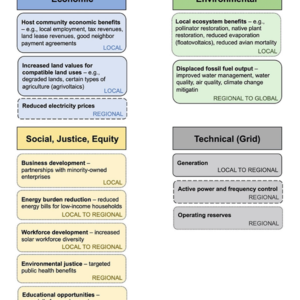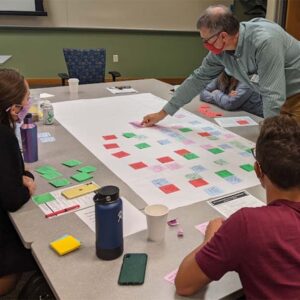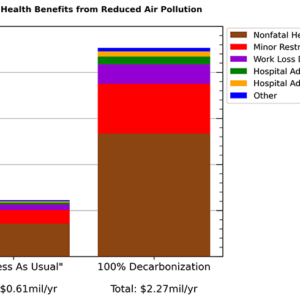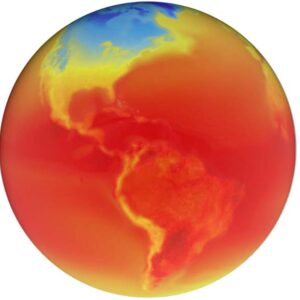The Nelson Institute Issue Brief summarizes the latest scholarship from the University of Wisconsin–Madison, highlighting faculty and graduate student work on key environmental issues. The Issue Brief is not a peer-reviewed publication. Contact the article authors or the editor, Morgan Robertson, at mmrobertson@wisc.edu with questions.
Introduction
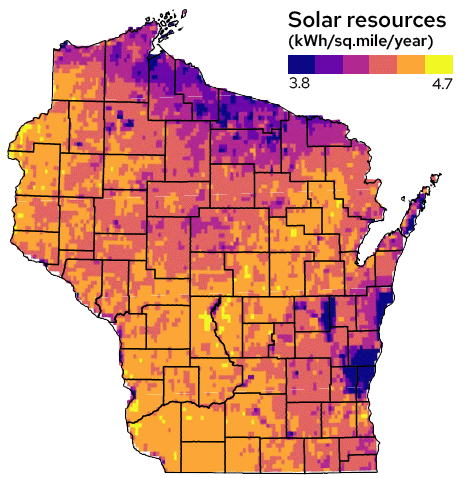
There is growing interest in shifting our energy systems from fossil fuels to renewable and alternative energy sources like solar, wind, hydropower, nuclear, and biofuels. Beyond climate benefits, these forms of alternative energy can create benefits for local energy costs, environmental quality, public health, and employment.
However, some significant barriers remain toward widespread alternative energy expansion. These can include: the quantity of mineral resources needed for energy infrastructure, land use requirements, concerns related to property value, health, and aesthetic impacts, and the need for greater energy storage infrastructure in addition to generating facilities.
As of June 2023, Wisconsin received 15.2 percent of its utility-scale electricity from nuclear power, and 9.1 percent from other renewables (hydropower, biofuels, wind, and solar), with the remaining electricity generated from methane gas and coal.
In 2019, Governor Tony Evers’ Executive Order #38 set a goal for all electricity consumed in Wisconsin to come from carbon-free sources by 2050. Recent proposals for solar and wind devel-opment across the Midwest have received both support and criticism from the public, sparking significant debate around the topic of alternative energy.
In this Nelson Issue Brief — the first of a two-part edition on the topic of renewable and alternative energy — we aim to contribute to these critical conversations by highlighting recent research from UW–Madison scholars that addresses alternative energy issues in Wisconsin and beyond.
The research presented here covers capacity building to support energy applications of satellite data, community engagement to identify and address local energy needs, estimating the economic and health benefits of grid decarbonization in Wisconsin, and a holistic framework for understanding the societal benefits of utility-scale solar expansion.
Key Points
The energy analysis and policy (EAP) program at UW–Madison facilitates the integration of satellite data into energy applications through collaborative workshops that connect a range of stakeholders to identify opportunities and overcome challenges.
Community engagement and collaboration are crucial for facilitating the transition to clean energy technologies in Wisconsin, despite challenges related to feasibility and political barriers.
Decarbonizing Wisconsin’s electricity grid is technically feasible and cost-effective, offering significant health benefits through the reduction of air pollutant emissions.
The impacts of utility-scale solar energy could encompass a range of economic, social, environmental, and technical benefits, and a more holistic framework for measuring and distributing these benefits can facilitate a more just energy transition.
Stories

A Holistic Framework of the Benefits of Utility-Scale Solar
Researchers studying “energy justice” have begun to explore how clean energy benefits and costs will be distributed with respect to demographic factors such as income and race.

What are Wisconsinites’ Perspectives on Community Energy Management and the Clean Energy Transition?
To address challenges posed by climate change and the energy transition, community needs may vary based on their unique social, political and cultural contexts, and not all communities are equipped to navigate the ever-changing landscape of emerging science and technology related to the energy transition.

Health Benefits for Electricity Decarbonization Pathways in Wisconsin
The largest health benefits are the reduction of nonfatal heart attacks and the reduction of days where restricted activity would be necessary for vulnerable people.

Satellite Data for Renewable Energy
Satellite observations with global or near-global coverage of the earth can support planning, siting, and operation of renewable energy systems.
